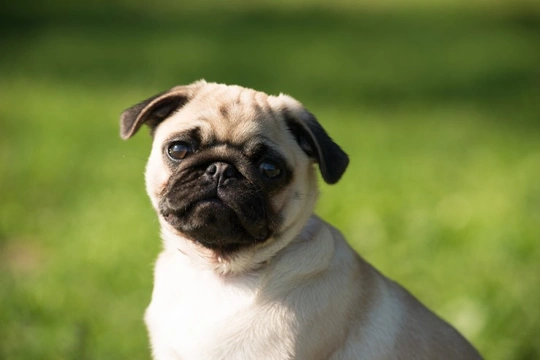
How to manage your pug shedding their coat
Pugs have short, flat coats that are generally thought of as being easy to care for, because they don’t get tangled or matted and can be kept clean without a lot of effort.
However, many people assume that a short, flat coat will also mean shedding is minimal – and this is not necessarily the case. Pugs are actually a heavy shedding breed, and many first-time pug owners spend their first year of ownership in a state of suspended disbelief that such a small dog with a simple coat can produce so much shed hair! This is one of the most commonly overlooked factors of pug ownership that first-time pug buyers don’t realise or fully appreciate before they bring their dog home, and then find it challenging to cope.
Pugs tend to shed their coats constantly throughout the year – rarely will you pat your dog without noticing a little shed hair disturbed by the process. Additionally, in spring and autumn when the seasons change, pugs – like most dogs – will also begin to shed in earnest, as they get rid of the old season’s coat and grow in a new coat to match the coming weather.
In this article we will share some tips and advice on how to manage coat shedding in the pug, and steps you can take to minimise its impact and keep your dog’s coat in good condition. Read on to learn more.
Pug coat colours and how they impact upon shedding
Pugs have a particularly interesting trait when it comes to their coat colours, which is fairly uncommon across all dog breeds and types – different pug colours mean different coat types and textures, although this is not obvious at a glance.
Black-coated pugs have a single layer of fur forming a topcoat without a separate undercoat, whilst fawn pugs actually have two layers of fur, being a short undercoat and another top coat. Both of these layers of fur are quite dense, and can shed quite heavily throughout the year. This means if you own a black pug, their fur is likely to be less prolifically shed than if you own a fawn one!
Grooming your pug
Many people assume that dogs with short coats don’t nee to be brushed and groomed, but this is something that all dogs can benefit from – particularly heavy shedding breeds like the pug.
Invest in a pinbrush or slicker and try to get into the habit of brushing your pug for just a few minutes each day, to remove shed hair, promote new hair growth, and keep your dog comfortable. Brushing the coat also boosts the circulation to the skin, which can improve its health as well as the texture of the coat itself.
Most pug owners clean and dry the skin folds of their dog’s face regularly, and so adding brushing into this routine of regular maintenance is generally simple enough.
Bathing your pug
All dogs need baths now and then, and the pug is no exception. Bathing your pug every few weeks will help to remove a lot of their loose and shed fur, which will make your dog more comfortable and minimise the amount of hair they shed in-between baths.
Use a mild, gentle shampoo that will soothe the skin and nourish it, not one that is overly strong and that may be harsh enough to strip the natural oils from your dog’s coat.
Checking for skin and coat problems
Brushing and bathing your pug gives you a valuable opportunity to check their skin and coat over and look for signs of problems. Keep an eye out for any sore or sensitive areas, rubbing in the creases of the skin, spots, rashes, hot spots or dandruff.
Also, check for fleas and parasites, and any changes to the appearance or texture of your dog’s coat and skin.
Shed hair in the house
Even if you’re really vigilant about brushing your pug, they will still shed hair within the house. To keep this under control, invest in a good hoover designed to pick up pet hair, and try to keep soft furnishings to a minimum or restrict the soft furnishings your pug is allowed to use.
Hard flooring rather than carpet is easier to maintain and remove hair from, as is leather seating rather than fabric sofas and cushions.
When to talk to your vet
The fact that pugs shed heavily is a surprise to many owners, but it is important to get to know your dog’s coat and shedding pattern so that you can identify any problems rather than just normal shedding behaviour.
If your dog suddenly begins shedding more fur than normal (taking into account seasonal changes) or if their coat texture feels rough, tacky or otherwise different – or if they shed a lot of dead skin cells as well as fur – you might want to ask your vet to check them over.
Very heavy shedding can indicate a skin irritation or similar problem, and finding out what this is and managing or resolving it can help to reduce shedding, as well as keeping your pug healthy and comfortable.



